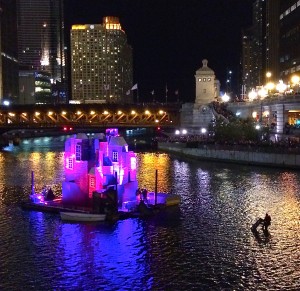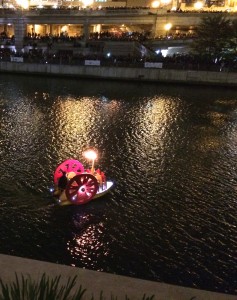How the Great Chicago Fire Festival burned history
17 November 2014 – Richard Anderson

One of the floating Victorian houses awaiting a burning that never quite arrived during the Great Chicago Fire Festival on October 4. Photo credit: Richard Anderson
As a public-historian-in-training and recovering theater nerd, I attended last month’s Great Chicago Fire Festival with high hopes. Redmoon Theater–one of the city’s most innovative companies–staged an elaborate pageant on the Chicago River commemorating the infamous 1871 fire that destroyed much of the city. Organizers promised the festival would “unite Chicago’s neighborhoods and celebrate Chicago’s grit, greatness, and renewal following the fire of 1871.” Unity and celebration certainly seemed palpable among the estimated crowd of 30,000 packed three-deep along the bridges and esplanade overlooking the river. I appreciate any effort to bring strangers together for a shared experience, especially one related to history. Yet the evening left me disappointed. The Great Chicago Fire Festival presented a version of history too sanitized and too simple. Redmoon lacked the courage to ask more discomfiting questions about the presence of the past in Chicago today.
The city’s power brokers viewed the $2 million event as a wise investment. Redmoon received $350,000 from Chicago’s Department of Cultural Affairs and Special Events and a $1-million contract from the Chicago Park District for community outreach programming. Sponsors like Boeing and the Pritzker Foundation (of Commerce Secretary Penny Pritzker fame) supplied the balance. With the money, Redmoon held a series of summer events in 15 Chicago neighborhoods, featuring cookouts and a traveling photo booth. Residents were encouraged to pose with a flame-shaped chalkboard upon which they had filled in one of two blanks: “I overcome______” or “I celebrate______.” Kids from neighborhood afterschool programs helped construct props and sets for the final performance.
The October 4th “Grand Spectacle” on the river began with an afternoon street bazaar at which festival organizers displayed residents’ photos collected over the summer. The bazaar boasted music, dance, poetry, and spoken word performances, in addition to food and crafts from each of the 15 neighborhoods. The evening’s main attraction began with dignitaries–including Mayor Rahm Emanuel, Illinois Governor Pat Quinn, actor Martin Sheen, and two stars of the television drama, Chicago Fire–lowering 15 flaming cauldrons (representing the neighborhood partners) from bridges onto boats below. A caravan of kayaks hauling flaming buoys passed, followed by the Chicago Children’s Choir, who performed on a touring vessel. Several homemade steamboats belched fires that were intended to ignite three floating Victorian houses. The festival’s climax was intended to come when those skeletal structures burned away to reveal interior sculptures representing Chicago’s symbolic rebirth.

A homemade steamboat makes a pass by the northern bank of the Chicago River so the crowds could catch a closer look. Photo Credit: Richard Anderson
All in all, it was an ambitious, potentially entertaining show. Unfortunately, an inadequate PA system left the proceedings largely unintelligible, and rain-damaged ignition switches prevented the houses from burning completely. As the temperature dropped and the delays mounted, many people, like me, skipped the closing fireworks and headed home. The festival’s problems ran deeper than the technical malfunctions that dominated news coverage, however. The entire event was misconceived.
Redmoon framed the Great Chicago Fire Festival as a ritual communal cleansing. Its programming linked a civic trauma from the past with contemporary challenges faced by city residents. To their credit, organizers chose some of Chicago’s poorest and most racially segregated neighborhoods. However, the festival offered those communities New Age bromides about healing and rebirth. Furthermore, the choice of historical subject matter felt like a cop-out. The fire of 1871 is an easy target. Not to deny agency to Mrs. O’Leary’s cow, but the fire functions in Chicago lore as an act of God, a freak accident that illustrated the need for smarter building practices. It also occurred 143 years ago. From such a safe historical distance and with no thorny issues of causation, the fire of 1871 becomes a harmless feel-good story–something our plucky ancestors survived, just like Chicagoans overcome obstacles today.
If Redmoon wanted to examine the human capacity for weathering adversity and coming back for more, they could have staged Thorton Wilder’s classic play, The Skin of Our Teeth. But if organizers wanted to pose searching questions about what has risen from the ashes of fire in Chicago, they could have delved into more recent history. Imagine if the festival had tackled the mid-century tenement fires that ravaged the city’s “Black Belt” or the flames that engulfed the West Side following Martin Luther King, Jr.’s assassination in April 1968. The resulting conversations would have been messier and less comforting but more productive.
Rather than exorcising demons from Chicago’s past, the event obfuscated more troubling and intractable historical legacies in the city’s present-day landscape. I watched the festivities at the foot of the new Trump Tower, a symbol of the staggering inequality that divides a steadily gentrifying Chicago. Wealth pours endlessly into the skyline showcased by the festival. Not so in the neighborhoods engaged by Redmoon. Every day, people of color in places like Englewood and North Lawndale confront the consequences of decades of deliberate exclusion and isolation by the city’s public- and private-sector elite.
That same elite heralded the festival as confirming Chicago’s status as a “world class city,” to use Rahm Emanuel’s oft-repeated slogan. Since taking office, the mayor has prioritized raising the city’s cultural and entertainment profile while cutting school budgets, attacking labor unions, and neglecting the same neighborhoods that played a role in Redmoon’s pageant. Emmanuel has also cultivated the high-tech industry. Ironically, the city’s publicly subsidized “tech hub” for budding entrepreneurs and disruptive innovators bears the name “1871”–the idea being that Chicago rebuilt its physical infrastructure following the fire and that it will likewise reinvent its economy for the new millennium. (Double irony: J.B. Pritzker, whose family’s foundation helped bankroll the Redmoon’s festival, was co-founded 1871.) The link between the festival and the tech hub is fitting. Where the arts and economic development meet in Chicago, history serves as a vehicle for postindustrial civic boosterism. Public historians have work to do amidst the ashes.
~ Richard Anderson is a doctoral student in twentieth-century American history at Princeton University. He received an MA in public history from the University of Massachusetts Amherst.




Wow! What an incisive and informative post! I appreciate your analysis of the festival and its missed opportunities. The next question is, faced with a culture of boosterism and the use of engagement of lower-income communities as a feel-good measure employed by elites, how do public historians get involved productively? If you rub people the wrong way, you risk being ignored, but if you don’t lend your voice, then you remain on the margins anyway? Always a tough question…